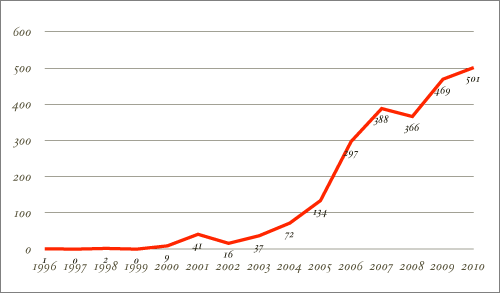Last night I went to a Portland screening of the feature-length documentary, “Sex+Moey: A National Search for Human Worth.” It was a brilliantly produced and well-structured film, but unfortunately it did not go beyond what I had expected from seeing the trailer which repeated the myth of extremely low the “Average Age of Entry” into prostitution. It also quoted people claiming that there are 100,000 to 300,000 trafficked children in the U.S., which is demonstrably false.
The film lost me from the beginning when the young white producers pushed their professional-quality cameras into massage parlors with Chinese signs, grilling the older Asian business owners and managers (who did not seem to be very fluent in English) about services they provide. They tried to trick the managers into offering illegal sexual services, but were unable to do so; later, the producers discussed among themselves that they should plan better. Well perhaps they should have partnered with Asian immigrants’ and workers’ advocates if they were serious about addressing the safety and rights of women who work there.
The producers claimed that they interviewed 70+ people around the country including sex workers. But the few sex workers and allies they “interviewed” were ambushed at the adult industry expo or while counter-protesting anti-prostitution demonstration. All other interviewees were treated more formally in their office, home, or other setting. A porn actor’s statement that she enjoys her job is followed by some “expert” explaining, without evidence, that vast majority of sex workers have been abused as children and learned to treat sexual violation as the norm.
The film kept going back to policymakers like Sen. Sam Brownback (now Governor of Kansas) and former Rep. Linda Smith (now the director of Shared Hope International, which has not responded to my questions about the discrepancy between its own study and its public statements) as experts. But they fail to mention that Sen. Brownback was one of the leading religious conservatives in the Senate that want to cut social services to fund tax breaks for rich people and corporations, and create harsher conditions for undocumented immigrants–both of which will exacerbate the problem of human trafficking. Former Rep. Smith also had her day as the anti-abortion, family values conservative, whose policies have devastated women and children (and also, people who signed up to receive updates about Shared Hope also receive anti-abortion materials). And yet, the film treats them like heroes. Oh yea, they also interviewed anti-prostitution activist Melissa Farley so that she can make all those outlandish generalizations that we are already familiar with.
Trafficking survivors’ stories describing the violence they experienced from pimps and johns were chilling, and yet I kept feeling how similar they were to the stories of women abused by their husbands and boyfriends. In fact, if I were to make a film that depict all marriages or even heterosexual relationships as inherently abusive, I could interview some survivors of domestic violence and edit the footage to show exactly that. It would not be persuasive only because many viewers know from their experiences that not all husbands and boyfriends are violent, and there are many loving, caring heterosexual men out there. But most (white middle-class) people are not familiar with pimps, and most johns do not admit to being johns, so people get very limited ideas about pimps and johns from films like this. Anti-prostitution activists decry the glorification of pimp culture in the media, which I tend to agree with (hey I don’t think it’s so hard out here for a pimp), but their depiction of pimps as sadistic monsters is also overly simplistic.
There was an interesting segment during the film in which producers grapple with whether it is appropriate to classify all prostitution as slavery. Several “experts” argued either that it was appropriate to do so, or that it was merely a matter of degrees. The representative of Polaris Project actually made sense for once–he pointed out that, while there are cases of severe human rights violation that appear indistinguishable from slavery, we must be careful about the use of the term “slavery” because the word has a specific historical context in the United States. I agree: slavery in the U.S. was a complex institution supported by the Constitution, the law enforcement, the commerce, and the rest of the fabric of the mainstream society, and should not be applied lightly to individual cases of rights violation or even to the underground, illegal activities as a whole. But then, the use of the word “Polaris” in the organization–the north star that guided escaped slaves through the Underground Railroad–does seem to contradict his careful positioning in the matter.
After the film, they brought up local “experts” fighting domestic minor sex trafficking for a panel discussion. The panel consisted of an attorney working for children in foster care, a supervisor at Oregon Department of Health and Human Services, and an assistant US Attorney who heads the Oregon Human Trafficking Task Force. The emphasis on the State and police power was evident, despite the fact that the very youth they are trying to “rescue” experience police harassment and abuse all the time.
I also found a handout created by Multnomah County at the resources table set up outside the auditorium which posits the logo of Janus Youth (social service provider for youth on the street) next to the logo of Portland Police Bureau. This is a bad idea. I know Janus struggles to maintain a cooperative relationship with the police when they need it while shielding youth from bad interactions with the police, but over the last few years I’ve seen Janus become closer and closer to the police in its public presentation as more of their revenues began to come from anti-trafficking grants while traditional funding streams have narrowed due to the economy, cutting street outreach and other programs, and I am alarmed.


